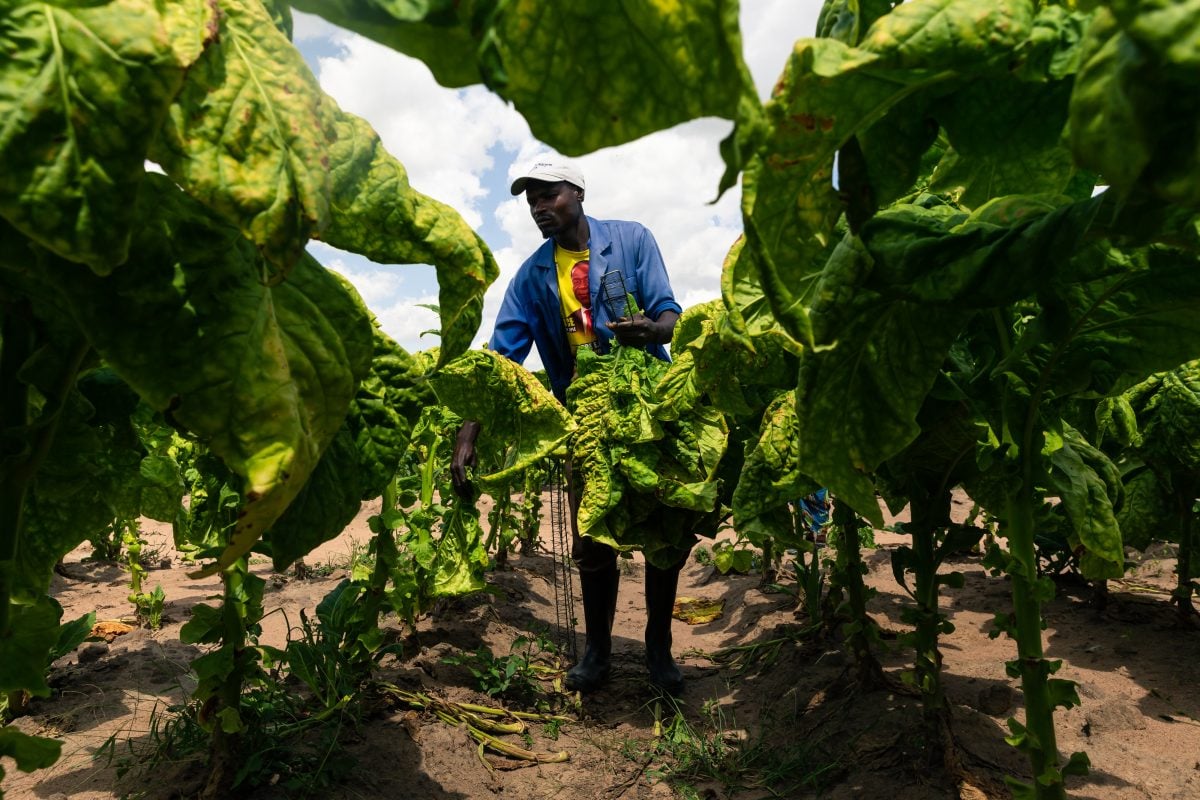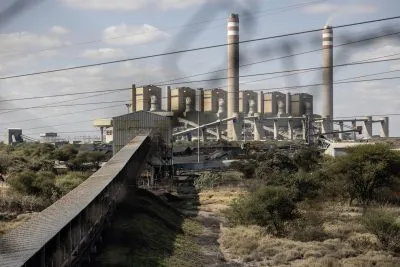Zimbabwe officially closed the tobacco marketing season earlier this month with a record-breaking output of 352.7m kg, worth a total $1.2bn.
This year’s tobacco output, which surpassed the target of 300m kg, increased by 51% from last year’s harvest. In 2023, the country recorded 296m kg, following a downturn in 2024 when output slowed to 234m kg due to a destructive El Niño-induced drought. The average 2025 price was $3.32 per kg, compared to $3.43 per kg in 2024.
While the 2025 rebound to a new record output may appear encouraging, experts warn that without interventions like expanded irrigation systems, future tobacco harvests will be exposed to climate-related weather shocks.
Future tobacco harvests at risk
Zimbabwe’s tobacco industry is no stranger to boom and bust cycles. Whenever there are erratic rains due to drought, tobacco harvests slump.
Tobacco is Zimbabwe’s largest agricultural export and a major foreign currency earner. China remains the largest market, with about 11% of Zimbabwe’s crop destined for the Far East, according to the Tobacco Industry & Marketing Board (TIMB).
Despite the strong season, Sydney Chisi, a Zimbabwean climate activist, says tobacco farming remains dangerously exposed to climate change.
“The low yields were largely because we had erratic rainfall at that particular time. We are beginning to witness erratic rains in Zimbabwe – we have droughts more often than not,” says Chisi, who is also an executive director at Reyna Trust, a climate justice organisation.
“And when the rains come, they will not be as good as expected, unlike the rains we got in 2024… we can also equate it to climate change.”
Zimbabwe, the world’s fifth-largest tobacco producer, has over 140,000 active farmers in the sector, the majority smallholders. Smallholder farmers, who for the most part do not have sophisticated irrigation systems, oversee about 75% of Zimbabwe’s tobacco production.
In 2024, Zimbabwe was hit by El Niño, a natural climate phenomenon in which surface waters of the central and eastern Pacific warm up, causing changes in global weather patterns.
An El Niño-prompted drought ravaged crops in 80% of the country that year, leaving more than half of Zimbabwe’s 15.1m people food insecure. Tobacco production was estimated to have fallen more than 10% in 2024 as a result.
The government declared a national disaster in April 2024 to mobilise resources from the state, private sector and international humanitarian organisations.
While there is no definitive agreement in the scientific community, recent studies suggest that global heating may be leading to stronger El Niño events, says Imperial College London’s Grantham Institute for Climate Change and the Environment.
Pressing need for more irrigation
The havoc wrought on the agricultural sector by El Niño and the fear of additional climate-change-related events has led to calls to future-proof tobacco and other cash crops.
Zimbabwe inherited a working irrigation system after the chaotic Land Reform Programme in early 2000, which saw about 4,000 white commercial farmers – many heavily active in tobacco – forcibly evicted from their land, ostensibly to make way for landless black Zimbabweans.
But decades after the Land Reform Programme, the country has struggled to maintain the inherited irrigation systems. Most of the equipment has deteriorated, according to reports from the auditor general. The government has also failed to expand existing working systems.
Casper Mlambo, a manager at Zimbabwe Tobacco Association (ZTA), says that while 2024’s tobacco rebound is encouraging, the government should construct more dams and invest in irrigation equipment.
“The government should give loans to farmers, which will go towards dam construction and drip irrigation systems,” he says.
George Seremwe, chairman of the Tobacco Growers Association, says the government, through its relevant ministries and departments, should offer maintenance and repair of damaged irrigation systems, especially to those cultivating former white-owned commercial farms where the systems have deteriorated.
Seremwe says a lack of water is affecting the availability of seeds as well as the productivity of the crop.
“In the 23/24 farming season, most farmers dropped out due to a lack of access to seedlings. This was as a result of the shrinking and disappearance of surface water bodies usually used as sources of watering nursery gardens,” he says.
He says seed production companies should develop and distribute fast-growing varieties that are resistant to drought and other climate-related stress, and adds that more research on climate-resilient farming practices and technologies is needed.
Chelesani Moyo, a spokesperson at the TIMB, the state-owned board which controls and regulates the growing, marketing and exporting of tobacco in Zimbabwe, says it has facilitated loan guarantees to help small-scale farmers in Mashonaland West Province access the financial resources needed to get centre pivots for irrigation.
“The aim is to replicate this in other provinces with the overall goal of progressively expanding hectarage under irrigation so that harvests are less vulnerable to rainfall variability,” she tells African Business.
Moyo says the tobacco industry is actively promoting climate-smart agriculture through conservation farming, efficient water use, and soil health management practices that help build resilience.
“Support is also being directed towards irrigation development, with TIMB working closely with contractors and financial institutions to assist growers in accessing the resources needed to move away from sole reliance on rainfall,” she says.
“In addition, capacity-building programmes are equipping farmers with the knowledge and skills to adopt drought-tolerant seed varieties and improved agronomic practices.”
Tobacco curing exacerbates drought disease
For tobacco to gain its desirable golden colour, farmers use firewood to heat the leaves in barns, removing moisture in a process called curing. This reliance on firewood causes extensive deforestation and environmental damage, which can further exacerbate droughts.
Statistics from Zimbabwe’s Forestry Commission show that Zimbabwe loses an estimated 262,000 hectares of forest annually, 15% to 20% of which is due to tobacco farming.
Environmental campaigner Chisi says farmers often have to rely on indigenous trees to cure their tobacco which are not subsequently replaced.
“We have seen a huge deforestation happening in communities that reduce tobacco,” he says. “While we compete and sprint towards high production, we are also sprinting towards deforestation.”
Seremwe says farmers should embrace renewable technologies like solar to cure tobacco to promote more sustainable tobacco production.
“The biggest challenge to us as small-scale tobacco growers is that those technologies are expensive and we do not have access to friendly credit facilities, therefore we resort to cutting trees from our surroundings,” he says.
Every tobacco farmer in Zimbabwe pays a levy which is collected by the government through TIMB and distributed to the Forestry Commission to fund afforestation projects. But experts say the government is lagging in these projects.
Seremwe says farmers are yet to witness the benefits of this levy.
Chisi says this levy has been limited to almost insignificant projects by the government and private players.
“A policy initiative has to be put in place to ensure that we have meaningful afforestation. Afforestation is not just about replacing indigenous forests with exotic trees like they are doing around the country,” he says.
“They have been growing eucalyptus trees that are dangerous to the soil and environment. We need fast-growing indigenous trees instead.”
Moyo says the law mandates every tobacco grower to establish 0.3 hectares of trees for each hectare of tobacco grown, which ought to create sustainable woodland.
She adds that further measures are being taken to reduce this impact, and says the TIMB is collaborating with institutions to explore alternative energy sources for curing such as using liquefied petroleum gas as a fuel source.
Until those measures are taken, there can be no guarantee that future seasons will be as bounteous as 2025.
Want to continue reading? Subscribe today.
You've read all your free articles for this month! Subscribe now to enjoy full access to our content.
Digital Monthly
£8.00 / month
Receive full unlimited access to our articles, opinions, podcasts and more.
Digital Yearly
£70.00 / year
Our best value offer - save £26 and gain access to all of our digital content for an entire year!

 Sign in with Google
Sign in with Google 



